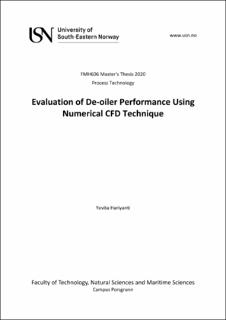Evaluation of De-oiler Performance Using Numerical CFD Technique
Master thesis
Permanent lenke
https://hdl.handle.net/11250/2724901Utgivelsesdato
2020Metadata
Vis full innførselSamlinger
Sammendrag
When producing oil from the reservoir, it comes together with water, gas, sand, and other impurities. Excluding gas, all of them are unexpected waste. The water or simply called produced water is the biggest problem due to its quantity and oil content. A produced water treatment should be performed before it is discharged to the sea or re-injected into the wells. External partner of this thesis, Subsea 7 is now developing a subsea separation technology called SPU (Subsea Processing Unit). SPU consists of some separation units, one of them is a de-oiler/hydrocyclone. This thesis will only focus on the de-oiler unit to reduce oil concentration in the produced water to be under 20-30 ppmv.
A literature review is conducted to choose de-oiler geometry based on separation efficiency. SALOME is used to draw and make a de-oiler mesh. The CFD simulation is conducted using OpenFOAM with the Euler-Euler model. twoPhaseEulerFoam solver is modified from its original example called bubbleColumn. The literature review has been done to examine various geometry and types of de-oiler for oil and water. Based on efficiency, the geometry for simulation is selected. From the results, the oil volume fraction in the water is found to be high which leads to low efficiency. The pressure drop is obtained to be very low compared to most of the literature, which is 0.02272 bar for 54.696 L/min and 0.0424 bar for 82.045 L/min. With the assumption of efficiency 76%, the number of de-oilers needed to separate 60000-80000 barrels of produced water per day varies between 25-162.
